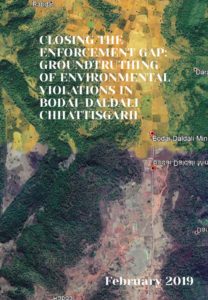Closing the Enforcement Gap: Groundtruthing of Environmental Violations in Bodai-Daldali, Chhattisgarh
By: Centre for Policy Research, Janabhivyakti, Oxfam India, Namati
Bharat Aluminium Company Limited (BALCO), which is a Public Sector Undertaking, received an environmental clearance in 2003 for bauxite mining in the Kabirdham district of Chhattisgarh. Since the mine became operational in 2003, there have been studies and media reports which have highlighted instances of non-compliance of environmental safeguards. There have also been complaints by affected villagers about impacts from mining and other ancillary operations. In this context, Janabhivyakti, along with Centre for Policy Research-Namati Environmental Justice Program and Oxfam India, initiated a groundtruthing process in 2018 to understand the impacts of this project on the people, which are linked to the non-compliance of Environmental Laws. Vanvasi Kisan Mazdoor Vikas Samiti from Bodai-Daldali also collaborated in identifying the impacts and outreach amongst the affected people. For this purpose, the permissions given to the project under the Environment Impact Assessment Notification 2006, Air (Prevention and Control of Pollution) 1981 and Water (Prevention and Control of Pollution) 1974 were obtained from the Ministry of Environment, Forests and Climate Change’s website (parivesh.nic.in) and by filing of Right to Information applications by the research team.
Following this, a groundtruthing exercise was conducted, whereby the facts stated in the official documents were compared to the impacts being reported by the affected villagers and the civil society organisation working in the area. Based on this discussion, the following issues were decided to be taken up by the research group to study through the groundtruthing methodology.
• Dust Pollution as a result of transportation, blasting and drilling
• Mined out pits in which backfilling has not been done, which runs the risk of children and cattle falling in
• Reported health risks and threats to the life of labourers
• Incomplete rehabilitation and resettlement process
• Fall in the groundwater level in the area
As required in the groundtruthing methodology, these reported impacts were then linked to the safeguards and mitigation measures required to be followed by the project proponent. Where there were instances of non-compliance, evidence was collected to verify the same. Efforts were made to maximise the participation of people affected by the mining operations in the area. However, some of these processes were hindered due to inaccessibility and political instability in the region. The non-compliance of environmental safeguards was further corroborated with government reports and studies conducted by other organisations. It was found that dust is generated due to uncovered trucks plying on poorly maintained roads, mining activities such as drilling and blasting, and despite that, the air quality monitoring was not being carried out by the project proponent. There was also no record of reclamation or evidence of plantation. The people still living within the mine lease area suggested that the R&R is yet to be completed. Alongside the environmental violations, the mine operated beyond its permitted capacity in the years 2006-07 and 2007-08. Recently, in 2017 after the MoEFCC allowed projects to get post-facto environmental clearances, this project has applied for such an approval, and the appraisal for a modernisation proposal is under way in the MoEFCC.

